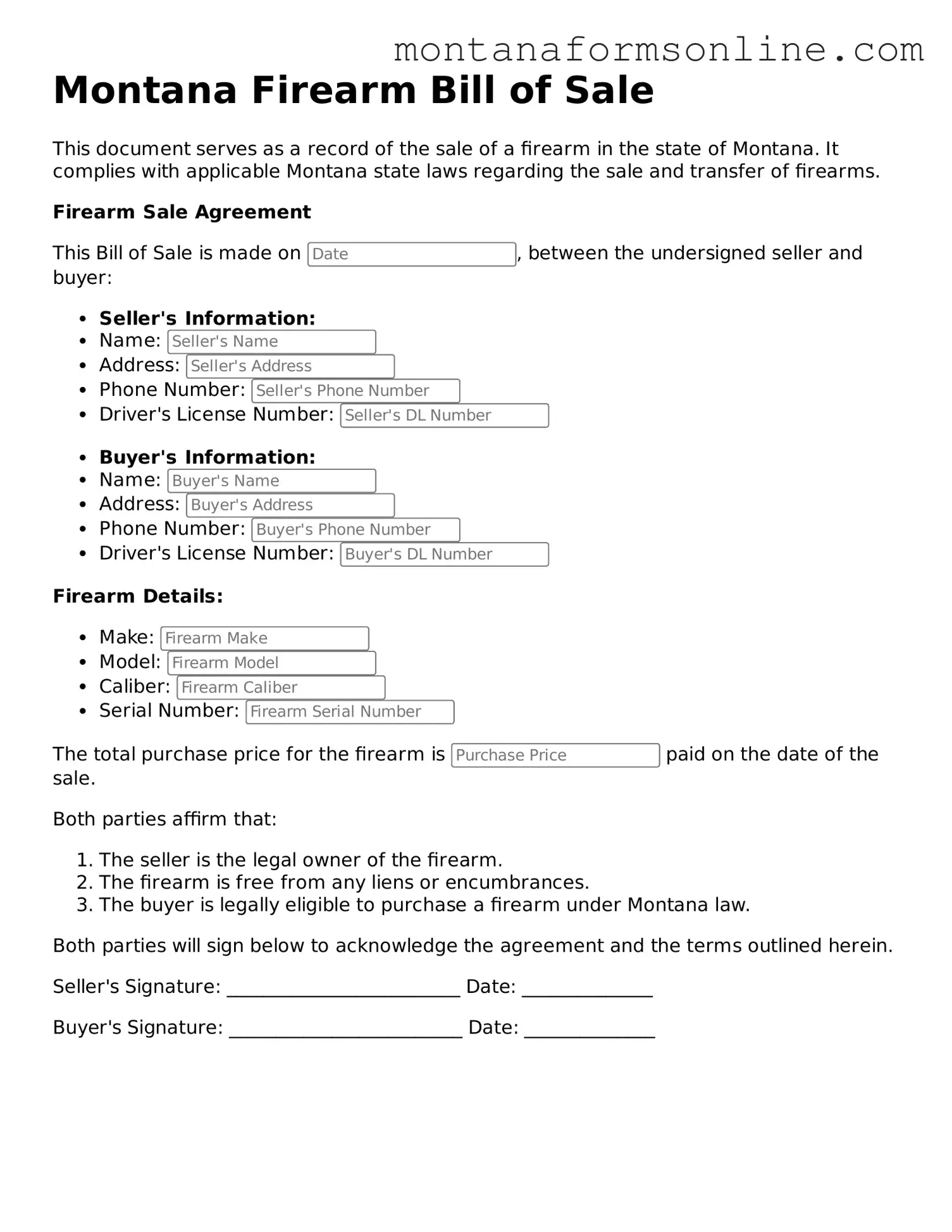The Montana Firearm Bill of Sale form shares similarities with the general Bill of Sale. A Bill of Sale is a legal document that records the transfer of ownership of personal property from one individual to another. Just like the Firearm Bill of Sale, it includes details such as the names of the buyer and seller, a description of the item being sold, and the sale price. This document serves as proof of the transaction and can be crucial for future reference, especially if disputes arise regarding ownership.
Another document closely related to the Firearm Bill of Sale is the Vehicle Bill of Sale. This document is used when transferring ownership of a vehicle, such as a car or motorcycle. Similar to the Firearm Bill of Sale, it requires information about the buyer and seller, a detailed description of the vehicle, including the Vehicle Identification Number (VIN), and the sale price. Both documents protect the interests of both parties and provide a record of the transaction.
The Equipment Bill of Sale is also akin to the Firearm Bill of Sale. This form is utilized for the sale of heavy machinery or other equipment. Like the Firearm version, it includes essential details about the buyer and seller, a thorough description of the equipment, and the sale amount. Both documents facilitate a clear transfer of ownership and serve as a legal safeguard for both parties involved in the transaction.
In addition, the Boat Bill of Sale is another document that bears resemblance to the Firearm Bill of Sale. When buying or selling a boat, this form captures vital information, including the names of the buyer and seller, the boat’s make and model, and the sale price. Both documents ensure that ownership is legally transferred and provide proof of the transaction, which can be important for registration and insurance purposes.
The Motorcycle Bill of Sale is similar as well. This document is specifically designed for the sale of motorcycles and includes pertinent details such as the motorcycle’s make, model, and VIN, along with the buyer and seller’s information. Like the Firearm Bill of Sale, it acts as a legal record of the transaction, helping to clarify ownership and protect both parties involved.
The Personal Property Bill of Sale is another comparable document. This form is used for the sale of various types of personal property, such as furniture or electronics. It includes the same essential elements found in the Firearm Bill of Sale, including the names of both parties, a description of the item, and the sale price. Both documents provide a clear record of the transaction and help to establish ownership rights.
In addition to the various types of bills of sale discussed, it is crucial to consider comprehensive legal documents that govern personal affairs, such as a Last Will and Testament. This form not only guides the distribution of one’s assets after passing but also emphasizes the importance of including specific wishes regarding belongings. For an in-depth understanding of this document and its implications, visit TopTemplates.info.
The Lease Agreement can also be seen as similar in terms of its function in transferring rights, albeit temporarily. While it does not involve a sale, it outlines the terms under which one party may use another party's property. Both documents require clear identification of the parties involved and a description of the property, ensuring that both parties understand their rights and obligations.
The Warranty Deed is another document that serves a similar purpose in terms of property transfer, though it specifically pertains to real estate. A Warranty Deed guarantees that the seller has clear title to the property and can legally transfer ownership. Like the Firearm Bill of Sale, it requires detailed information about the buyer and seller and provides legal protection to the buyer regarding ownership claims.
The Power of Attorney can also be compared to the Firearm Bill of Sale in that it allows one person to act on behalf of another in legal matters. While it does not involve a sale, both documents require clear identification of the parties involved and outline specific rights and responsibilities. This ensures that transactions, whether for firearms or other matters, are conducted legally and with the necessary authority.
Lastly, the Trust Agreement can be seen as a similar document, especially in the context of estate planning. A Trust Agreement outlines how assets, including firearms, should be managed and distributed. Both documents require detailed information about the parties involved and the items in question, ensuring that ownership and responsibilities are clearly defined.
